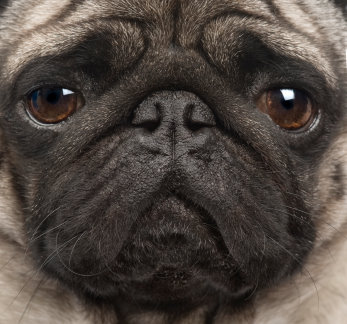|
Pug Training Basics
One of the myths about Pug training is that it is a difficult process and that this breed in general is harder to train than the average dog. While it is true that Pugs are not an average dog (we think they’re cuter and more intelligent), it is wrong to assume that they are any more difficult to train than the average dog especially if you follow some basic guidelines. The benefits of a well-trained Pug are numerous and there is nothing more enjoyable than being in the company of an obedient dog who happens to be a member of one of the most adorable of all breeds. It is worth the time and effort to train your Pug at an early age. To avoid frustration it is probably wise to spend a little time investigating some of the training resources that are available. The good news is that a lot of it is free and most of the rest is very affordable and of excellent quality. If money is no object and you don’t have the patience for Pug training you can certainly spend some money to have a professional train your dog. But, really, you don’t have to spend any money at all because some of the training is just common sense. There are different levels of training. The one most people overlook is the socialization aspect where you introduce your Pug to different situations beginning as a puppy. Here you teach your Pug how to get used to the activities in your house and how to react to strangers. For most owners one of the most important aspects of Pug training is housetraining. Here, as with every phase of training you want to keep the tone of your training activities positive. Never punish mistakes. Yelling at your Pug for a lapse does no good at all and will create some hostile reactions. If you catch your Pug “in the act” you want to scoop him up and get outside as soon as possible. Always praise him when he goes outside properly. Taking him to the same spot will also help. Once he finds that spot keep taking him there because the smell will be a trigger for him. That’s one reason not to clean up any accidents that have occurred in the house with a cleaning agent that contains ammonia. Ammonia is contained in urine so by cleaning with that type of ingredient you will only continue to trigger that sensation to go. Pugs can take from 12 to 16 weeks to housetrain housetrain. The key to success is consistency and maintaining a schedule that will work with your young puppy. Take your puppy out on a leash and choose a word or phrase that you Pug will associate with this activity such as “go potty”. As a puppy you will need to take him out on short intervals. You cannot expect a small Pug to be cooped up in a house for 8 hours. It just doesn’t work. If you have no choice in leaving him for that length of time then paper training is something to consider. There actually have been books written on the subject of potty training. It is one of the first things you want to you will want your Pug to master. We have looked at many programs and if you would like information on one of the better ones Click Here! There's also a free mini course on puppy training offered here:
You should also want to consider crate training as part of your Pug training. Most people’s first reaction is that a crate is cruel but that is just not the case. Pugs crave a place of their own and prefer a contained and covered area because they feel more secure in that location. Getting your Pug used to a crate is very beneficial especially if you need to leave him alone for extended periods and do not want him to have free reign in the house. Your Pug’s crate can actually be a valuable part of housetraining especially if the crate is where he sleeps. A Pug does not like to soil its own bed so he will be more inclined to “hold it in” until you let him out first thing in the morning. You will want to watch for the body language of your Pug and react as quickly as possible. If your dog is crated and starts whimpering it definitely could be a sign that he has to go outside. A housetrained Pug will go right to the door and wait and may even scratch at the door as the urge increases. Pugs are food motivated so it is easy to find a reward that they will appreciate. But don’t forget they also are happy to hear kind words and get the undivided attention of their owner. Pugs are eager to please and that is an important part of Pug training. While perhaps not as easy to train as Golden Retrievers or Collies, Pugs are definitely trainable and can learn all of the standard commands such as sit, come, down or stay. There are many books on the subject and positive reinforcement will be a key part of any successful Pug training strategy. The days of swatting your dog and yelling have, thankfully, been replaced by a more scientific and safer approach to training your Pug. Pugs are unique and, while almost any good general dog training book will work, it might be worth the time to investigate specific Pug training reference manuals or resources. Training your Pug can be a great bonding activity and you might be surprised how much your dog learns and how much he enjoys it especially if you break the sessions down to ten to fifteen minutes lessons. After that your Pug may lose interest and your time may be counter productive. It may sound obvious but the best time to start training your Pug is when he is young. Starting to train your Pug as a puppy just makes it easier for both you and your Pug. One of the most important parts of training is the socialization process and that definitely works better the earlier it starts. Pug Behavior problems can definitely be remedied. It requires a little work but there is help in addressing behavior problems and other elements of Dog Training. Taking the time to train your Pug will be time well spent!

|

